#WD&HO Wills
Explore tagged Tumblr posts
Text



WD & HO Wills Tobacco Factory in the Centre of Bristol UK
W.D. & H.O. Wills was a British tobacco manufacturing company formed in Bristol, England. It was the first British company to mass-produce cigarettes, and one of the founding companies of Imperial Tobacco along with John Player & Sons.
The company was founded in 1786, and went by various names before 1830 when it became "W.D. & H.O. Wills". Tobacco was processed and sold under several brand names, some of which were still used by Imperial Tobacco until the second half of the 20th century. The company pioneered the use of cigarette cardswithin their packaging. Many of the buildings in Bristol and other cities around the United Kingdom still exist with several being converted to residential use.
The brand "Wills" was withdrawn by Imperial Tobacco in 1988 for the majority of its products
Many of the original buildings have been demolished but others remain and have been repurposed for communal use and office space...
The TOP image shows the 'New" factory and Headquarters of Imperial Tobacco built in 1974 in the district of Hartcliffe Bristol. Tobacco products ceased to be produced in the late 80's early 90's and this building was partly demolished in 1992 and the site redeveloped into Retail, Leisure, Communal, Office, and Podium Space and renamed Imperial Park.....
0 notes
Text
Fear the Walking Dead reactions.
The series finale of Fear the Walking Dead was fantastic! The character I most wanted to survive did. The character I most wanted to have a successful redemption arc did. They even finally plugged the plot hole of the missing cat.
Fear the Walking Dead is far and away my favorite of the WD shows. It was through the lens of the villains as protagonists. Madison, Victor, Daniel, Troy and Travis (the poster boy for "Nice is not good") were all broken before the dead started walking. (Seriously, just how many communities did Madison and Daniel destroy over the course of the series?) Ofelia and Chris were twisted and destroyed by what came after. Recovering drug addict Nick was the heart of the show and Alicia was the conscience, which was why they kept trying to flee their family. But even they walked down a dark path for a while after Madison's death. Only Luciana was a hero for almost all of the show's run, except for a brief flirtation with villainy after Nick's death. The series was at its best during the first three seasons, with season 2's Mexico arc being my favorite. I feel the show went off the rails beginning with the Diamond arc, when Madison seemingly made a heel-face turn off-screen, and we were supposed to accept her as good now. And when Morgan, who was my favorite character on TWD, came on FTWD, he just didn't seem to fit. His gung-ho optimism wasn't really the tone I was expecting for the show. While there were some fun characters introduced later (I adored Grace), the episodes just felt uneven and often unbelievable. And the apocalypse being interrupted by an apocalypse seemed like jumping the shark. Then we got part II of the final season (spoilers ahead for the finale):
Fear the Walking Dead was back! This is the show I'd fallen in love with. First up, Luciana survives! She is my favorite character of the series, and of the TWD universe in general. She is a protector, but not at all naive. She has compassion and will help strangers, but is smart about it. I loved learning what she had gotten up to during the 7-year time jump. She created a new community, and continued Morgan's mission in a much more sustainable and less dangerous way. She was willing to help people, so long as it didn't put her community in danger. And her eyes were wide open about the flaws of Daniel, Victor, and Madison. I'm also so happy she and Daniel have formed a family. He will hold her back from going on suicidal rescue missions, and she will keep him on the straight and narrow. My only complaint is that we didn't get more Luciana-centric episodes. The three-way confrontation between Madison, Victor and Daniel was fantastic, as they were all right about each other. They'd pretty much sized each other up in season 1. Madison saw Daniel as useful, and Daniel respected Madison (but not Travis, who he saw as pathetic.) Daniel and Victor correctly saw their own flaws in the other, and so hated and mistrusted one another. And Madison and Victor were evil soul-mates.
I love that all three finally got their heel realization moments. In this season they all finally realized how their actions had harmed others, and Daniel and Victor at least felt guilty about it.
And Victor got a successful redemption arc! I so wanted that for him. He gets a happy ending! Madison, as always, was a Magnificent Bastard par excellance. And while I've always hated Troy, it just felt right that he was back. He and Madison had this twisted relationship where Troy saw Madison as his mother and Nick as his brother, and Madison exploited that until he was of no further use to her. The fact that she sees his daughter as her granddaughter is sort of like Troy winning in a way. And I laughed out loud when Daniel was reunited with his cat. Yes, it's completely unbelievable, but it made me happy so I'll allow it. ;-)
All in all, a fantastic ending to a roller coaster of a show. This is one I'll miss.
1 note
·
View note
Text










WD & HO Wills’ cigarette cards - ‘Cinema Stars’ series, 1928.
#vintage#cigarette cards#old hollywood#classic hollywood cinema#bebe daniels#billie dove#blanche sweet#clara bow#dolores costello#lillian gish#mary astor#norma shearer#norma talmadge#renee adoree#vintage cigarette cards#art#hollywood art#hollywood#classic cinema#classic hollywood#1920s#20s#golden age of cinema#old hollywood stars#old movie stars#hollywood aesthetic#vintage aesthetic#vintage vibes
103 notes
·
View notes
Text
@hella1975 (Apparently asks have limits on this hellcite so I have to make a post and tag you)
So I have read many scholarly articles on tobacco companies and have come to the conclusion that your grandpa was right and that they are shady af. While not finding any evidence on them using fillers to lower production cost, it is 100% something up their alley of doing. Here are some interesting quotes I found,
“The tobacco companies have been consistently deceptive over the long term about their motivations and activities [ 8] , complicating ethical analyses. They are governed by the profit imperative and legally mandated to maximize shareholder value [ 9] , and not to act in the public interest.”
That quote is about them funding ‘studies’ that e-cigarettes are a-okay because they realize that public opinion is turning away from traditional forms of tobacco and they still want to find a way to stay relevant and make a profit.
“The tobacco industry has been well aware that much of the scientific research it commissioned was doubtful and usually geared toward thwarting liability claims and developing a strong public relations front.”
“Associates for Research into the Science of Enjoyment (ARISE) is a nonprofit organization primarily funded by tobacco industry companies and led by psychologist David Warburton of the University of Reading in the United Kingdom. The group's stated purpose is to "discuss the ways in which 'everyday pleasures' such as eating chocolate, smoking, drinking tea, coffee, and alcohol, contribute to the quality of life."( n19) Warburton is frequently cited by the tobacco companies as the primary support for their claim that nicotine is not addictive”
“The tobacco industry's heavy financial support of this group also makes the objectivity of their research questionable. For example, a member of ARISE, Dale Atrens, testified in a smoking case on behalf of British American Tobacco's Australian subsidiary, WD&HO Wills, that research did not persuade him that smoking causes cancer.”
These three lovely quotes have to do with tobacco companies paying the big bucks for fancy lawyers and using ‘junk science’ with so-called ‘expert witnesses’ so they win cases in court.
Other things I found was that they didn’t start getting big regulations until the 90s, meaning they would have been doing questionable things while your grandpa was working there.
#the art of burning#Avatar The Last Airbender#me doing way too much research into a throwaway comment made last chapter bc im a nerd
22 notes
·
View notes
Text

Imperial Tobacco Company
102-116 South Sixth Streets (Warehouse & Stemmery)
Built, between 1877 - 1896
Demolished, unknown
118-120 South Sixth Street (Office)
Built, 1904
Demolished, after 1977
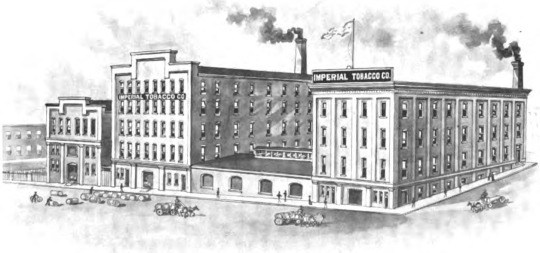
[RVCJ03] — showing Stemmery & Warehouse at Sixth & Main SW
The British tobacco bully-boys. What’s wrong with a little friendly competition?
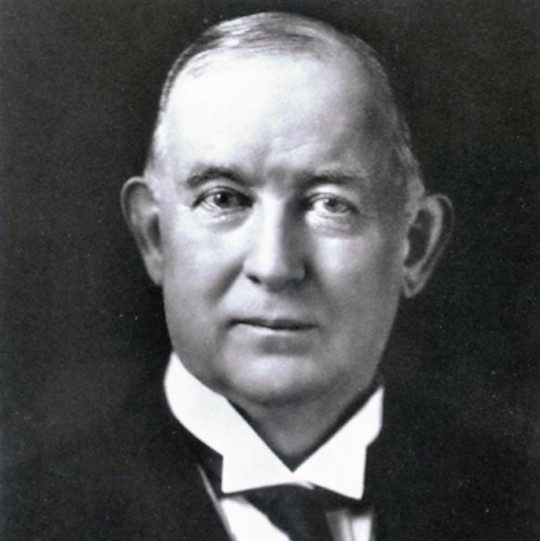
(Duke University Libraries) — James Buchanan Duke
This is one of the quaint stories of the Gilded Age, those good old days when men were men and trusts were normal.
The American Tobacco Company (ATC) set aside a massive 30 million dollars to buy up British tobacco companies one by one at the start of the 20th century. The key figure was James Buchanan Duke, head of ATC, whose aggressive methods had created a virtual monopoly for the company in the US. Individually, British companies, even those of the size of WD & HO Wills and John Player & Sons, could not survive.
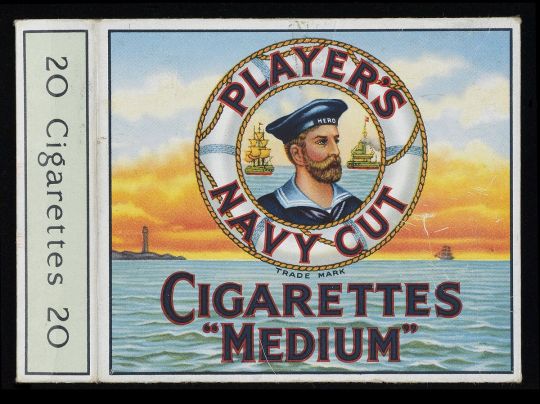
(Wikimedia Commons)
When Duke arrived in Liverpool in 1901, he walked into Ogden's factory and bought on the spot. Duke then approached other British companies and is reported to have burst in on the Player brothers, saying: "Hello, boys. I'm Duke from New York, come to take over your business." He was politely shown the door, an experience repeated at other companies. Facing such resistance, he paused for reflection.
This pause gave 13 family-run businesses, led by Wills, Players and Lambert & Butler, time to meet and, in December 1901, The Imperial Tobacco Company (Great Britain and Ireland) Limited was formed. (Imperial Tobacco)
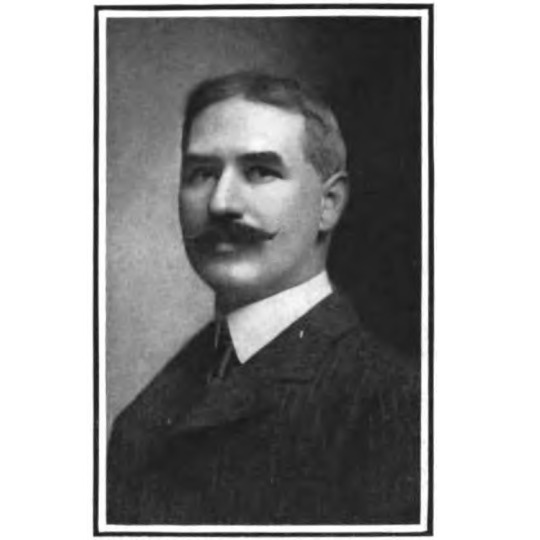
[RVCH03] — Wellford C. Reed
Duke’s bluster would come back to haunt him, and it wasn’t long until the fight was brought directly to American Tobacco’s doorstep.
According to information received in the city, Mr. A. F. Thomas of Lynchburg, who, along with Mr. Wellford C. Reed, of this city, was appointed to represent the Imperial Tobacco Company in this country, will remove to this city and will establish himself here. He as sold out his place in Lynchburg and is preparing to make a change in his residence. It is understood that he will come here tomorrow, though hardly to settle here so soon. This will probably be a preliminary visit, with a view to securing residence, office, &c.
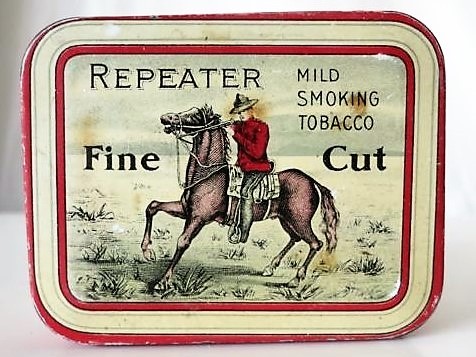
(Pinterest) — tin of Repeater, fine cut mild smoking tobacco, product of Imperial Tobacco Company of Montreal, Canada
The determination of Mr. Thomas to locate here casts more mystery than ever over the plans of the Imperial Company with reference to this country. When he and Mr. Reed were appointed it was thought that the two would divide the territory between them, Mr. Reed looking after Virginia and the Carolinas and Mr. Thomas the West, or vice versa. This arrangement seems to be knocked in the head by Mr. Thomas’ action in locating here. It may be, however, that he will undertake to conduct the Western business from this point. One thing seems to be signified by the coming of Mr. Thomas to this city, namely: that Richmond will in reality be the American headquarters of the Imperial. [RT19020315]
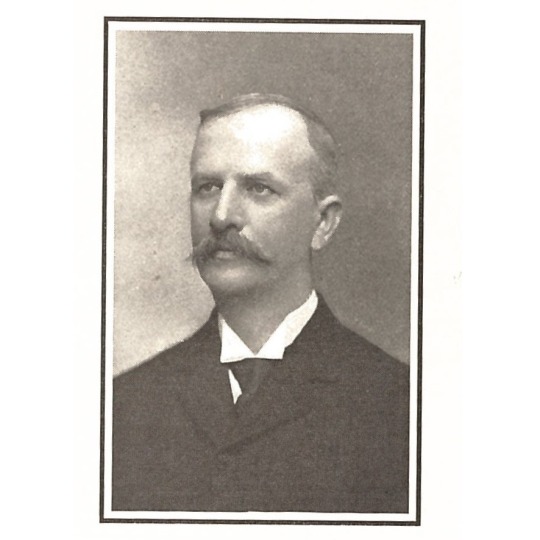
[RVCJ03] — James N. Boyd
They started by taking over the buildings of James N. Boyd, a former leaf tobacco broker who’d found a new occupation as President of the Planters Bank and Virginia Trust Company. His warehouse and stemmery commanded most of the western block of Sixth Street between Cary and Canal Streets, a clear finger in the face to Duke, whose American Tobacco buildings stood right across the street.
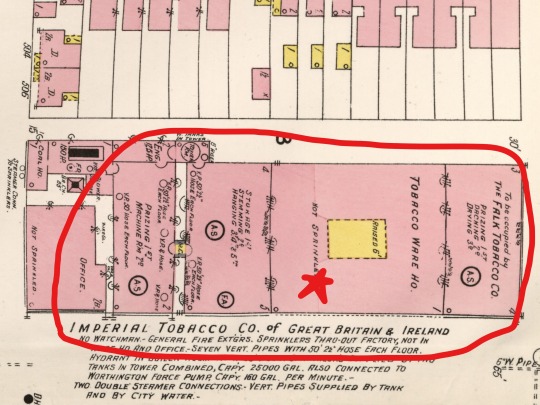
(Library of Congress) — Sanborn Fire Insurance Map from Richmond (1905) — Plate 11 — showing 102-116 South Sixth Street locations
Nor did it take long for Imperial to make its presence known, leaning hard on its British brethren to not do business with American Tobacco.
London, March 21 — At a meeting of the Edinburg Association of Retail Tobacconists, to-day, a resolution was adopted unanimously declining to sign the Imperial Tobacco Company’s agreement not to sell American goods for a term of years, but expressing a willingness, if the minimum price is raised so as to allow a fair profit to the dealers, to do what is possible, bonus or no bonus, for the sake of British goods. The chairman declared that no one outside a lunatic asylum would sign such an agreement, which would make them the servants of the Imperial Tobacco Company. While the Americans offered a large bonus, no restrictions were placed upon the dealers. [RD19020322]
Indeed, the London tobacconists felt that Imperial Tobacco Company offer “out-Americanized the Americans” and was “unjust and unfair to the dealers, and un-English.”

May 2019 — looking towards 102-116 South Sixth Street today
Such resistance had limits, as Imperial continued to come out swinging, with two announcements in May alone.
The Universal Tobacco Company of this country, it is learned, will work with the Imperial Tobacco Company, of Great Britain, against their common foe, the American Tobacco Company, through a co-operative alliance altogether different from what has bee supposed.
The scheme of co-operation, according to the information received, is to have the Universal Tobacco Company become the selling agents for the Imperial in the country and the Imperial for the Universal in England and Europe.
Such an alliance would be an exceedingly strong one and would be hard to beat. [RT19020511]

[RTD19040177] — Plans for Imperial Tobacco Company’s Splendid Office Building, Sixth and Cary — Richmond Times-Dispatch, Sunday, January 17, 1904
This was followed just three days later with the announcement of the acquisition of the Well-Whitehead Tobacco Company of Wilson, North Carolina.
In July, the Richmond Dispatch announced that British tobacco dealers had been notified that the Imperial was arranging for direct imports of Virginia and Carolina leaf, effectively freezing out American firms from selling to British manufacturers. Later the same month, the Dispatch ran another story that described Imperial’s intention to compete aggressively in the Farmville market during the next tobacco-buying season.
While the general public know nothing of the merits of the alleged controversy between the Imperial and American “giants,” every farmer is in high hopes of larger profits from his labors by reason of the anticipated struggle between these companies. [RD19020713]
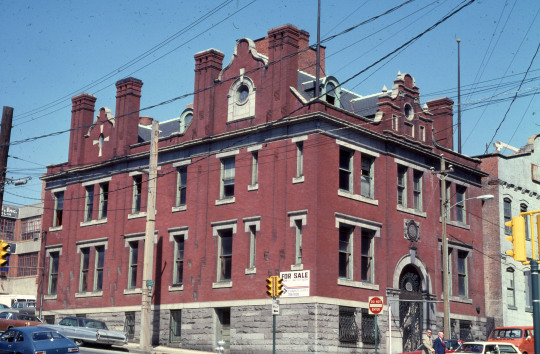
(Vintage Richmond) — Imperial Tobacco Company building — March 1977
Duke tried fighting back.
Through Ogden's, American Tobacco Company began cutting prices and offering free gifts in the UK - tactics that had served it well in the US. But Imperial frustrated ATC at every turn. It acquired the retail business of Salmon & Gluckstein and also set up a customer bonus scheme, whereby a proportion of Imperial profits was distributed among wholesale and retail customers.
After suffering heavy losses in the UK, and faced with a trade war at home, ATC was ready to talk. In September 1902 an agreement was reached - ATC surrendered Ogden's to Imperial while Imperial abandoned plans to enter the American market, except for leaf buying. The result was the formation of the British American Tobacco Company Limited. (Imperial Tobacco)
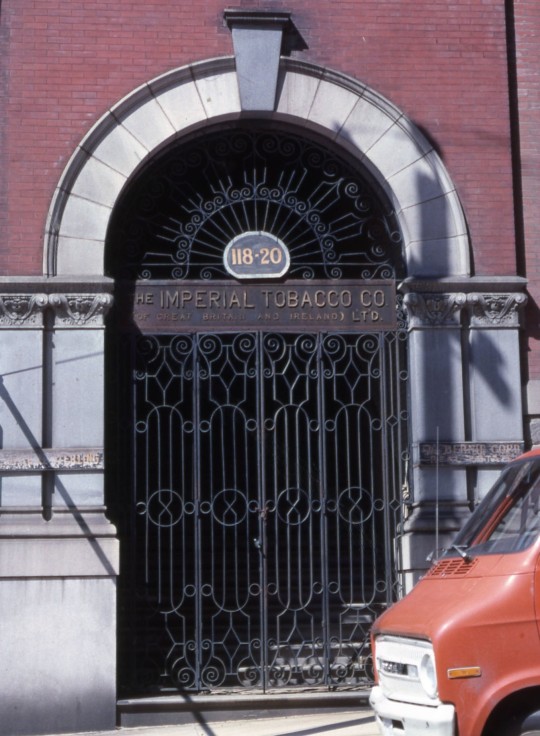
(Vintage Richmond) — Imperial Tobacco Company doorway — March 1977
The cessation of hostilities allowed Imperial the luxury of planning a brand new office building, which was constructed in 1904, right across the street from the warehouse and stemmery. Sadly, the giddy good times did not last.
In 1907, American Tobacco Company was indicted in violation of the Sherman Anti-Trust Act of 1890. They fought it all the way to the Supreme Court, and in 1911, the justices issued their decision in United States v. American Tobacco Company, holding that American was indeed guilty of attempting to monopolize the business of tobacco in interstate commerce.
The tobacco giant was split into four smaller companies: American Tobacco Company, R. J. Reynolds, Liggett & Myers, and Lorillard. American Tobacco continued to hold the rights to sell a number of Imperial brands in the US, leaving Imperial free to export any of its other brands to the American market. (Imperial Tobacco)
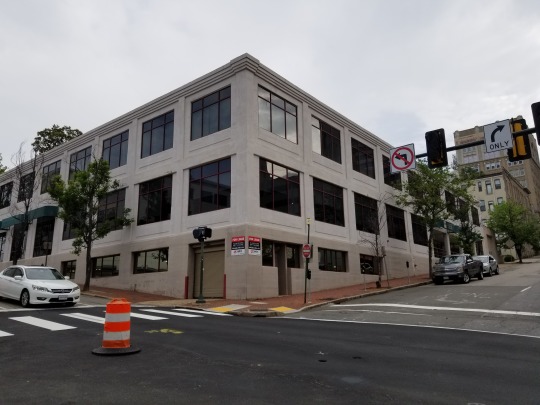
May 2019 — looking toward 118-120 South Sixth Street today
Imperial may have seen the writing on the wall and elected to bail for greener pastures. A 1908 article in the Richmond Times-Dispatch discusses the company’s contemplated move to Henderson, Kentucky, and their transformation into Imperial of Kentucky. Great things were anticipated from the exploitation of the great Western tobacco belt, and they expected to construct a new rehandling plant in Henderson. [RTD19080305]
The warehouse and stemmery buildings continued to be used by Imperial as late as 1924, but the office building became a warehouse for the Western Electric Company, and then Graybar Electric by 1950.
(Imperial Tobacco Company is part of the Atlas RVA! Project)
Note
The always readable Shockoe Examiner has plowed this same topic in a post from 2018. There are additional pictures and details about the office building that are worth checking out.
Print Sources
Newspapers provided by Chronicling America.
[RT19020315] Richmond Times. Saturday, March 15, 1902.
[RD19020322] Richmond Dispatch. Saturday, March 22, 1902.
[RT19020511] Richmond Times. Sunday, May 11, 1902.
[RD19020713] Richmond Times. Sunday, July 13, 1902.
[RTD19040177] Richmond Times-Dispatch. Sunday, January 17, 1904.
[RTD19080305] Richmond Times-Dispatch. Thursday, March 5, 1908.
[RVCJ03] Richmond, Virginia: The City on the James: The Book of Its Chamber of Commerce and Principal Business Interests. G. W. Engelhardt. 1903.
1 note
·
View note
Photo

Days pass and I’m still packing things for customers, I’m so grateful for that and to my postman who comes to pickup my stuff. The most improbable sale this week: a compass for architects which was sent to Belgium! The magic of the Internet... This is the most charming #album of #wildflowers #wd&ho #wills #cigarettecards from #uk - It is packed and will go to Las Vegas, Nevada tomorrow #coronavirusperiod #covid19period https://www.instagram.com/p/B-YBXykBrhw/?igshid=1rxjj5rz22sep
0 notes
Photo

Three Castles Tobacco Can $2.05
http://www.ebay.com/itm/Three-Castles-Tobacco-Can-4817-42-Misc-collectibles-/222596940979
The can measures 4 x 2 (approx.). On the lid it has the wording The Three Castles Tobacco WD & HO Wills Bristol & London. There’s no sweeter tobacco comes from Virginia & no better brand than the Three Castles. 3 ¼ oz. mild fine cut tobacco. Made in Great Britain. There is a sticker on the bottom but it isn’t readable. There is rust and wear on the can and still a few grains of tobacco inside the can. (PLEASE READ: I’m elderly and can’t smell very well so I can’t tell if the previous owner was a smoker. All books come from estate, tag or yard sales so I don't know if the previous owner was a smoker nor if they had an animal. Selling as is. Buy more than one item and save on postage.
1 note
·
View note
Text
Many reasons to be grateful to Bristol's tobacco women | Letters | UK ... - The Guardian
The Guardian
Many reasons to be grateful to Bristol's tobacco women | Letters | UK ... The Guardian Jane Nation (Letters, 9 April) gives proper attention to the thousands of women workers who fuelled the success of WD & HO Wills in their Bristol tobacco company, providing the profits for which Bristol University can be thankful. In fact the Wills ... and more »
from tobacco - Google News https://ift.tt/2qyCQEj
0 notes
Photo

Women who gave Bristol a university | Letters | UK news Peter Malpass (Letters, 3 April) is right to highlight the fact that WD & HO Wills recruited many Bristolian women and girls to work in their Bedminster factories.
0 notes
Text

The Mauretania Public House is on Park Street in the English city of Bristol.
It was built in 1870 by Henry Masters, with a rear extension being added in 1938 by WH Watkins. It has been designated by English Heritage as a grade II listed building. The Mauretania is situated at the Bottom of Park Street in the centre of Bristol opposite the Cathedral and adjacent to Bristol City Hall
Many of the Art Deco furnishings and fitting from the RMS Mauretania were installed in the bar/restaurant, initially called "Mauretania", now "Java". The lounge bar was the library with mahogany panelling: above the first-class Grand Saloon with French-style gilding. The neon sign on the south wall still advertises the "Mauretania": installed in 1938 this was the first moving neon sign in Bristol. and has recently been renovated.
The Illuminated Tower at the top of Park Street is the WD&HO Wills Building of Bristol University.
16 notes
·
View notes
Photo

1934 WD & HO WILLS RADIO CELEBRITIES JACK HYLTON http://rover.ebay.com/rover/1/711-53200-19255-0/1?ff3=2&toolid=10044&campid=5337506718&customid=&lgeo=1&vectorid=229466&item=201802636319
0 notes
Photo

1934 WD & HO WILLS RADIO CELEBRITIES JACK HYLTON http://rover.ebay.com/rover/1/711-53200-19255-0/1?ff3=2&toolid=10044&campid=5337506718&customid=&lgeo=1&vectorid=229466&item=201802636319
0 notes
Photo

1934 WD & HO WILLS RADIO CELEBRITIES JACK HYLTON http://rover.ebay.com/rover/1/711-53200-19255-0/1?ff3=2&toolid=10044&campid=5337506718&customid=&lgeo=1&vectorid=229466&item=201802636319
0 notes
Photo

Three Castles Tobacco Can $2.10
http://www.ebay.com/itm/Three-Castles-Tobacco-Can-4817-42-Misc-collectibles-/322716953248
The can measures 4 x 2 (approx.). On the lid it has the wording The Three Castles Tobacco WD & HO Wills Bristol & London. There’s no sweeter tobacco comes from Virginia & no better brand than the Three Castles. 3 ¼ oz. mild fine cut tobacco. Made in Great Britain. There is a sticker on the bottom but it isn’t readable. There is rust and wear on the can and still a few grains of tobacco inside the can. (PLEASE READ: I’m elderly and can’t smell very well so I can’t tell if the previous owner was a smoker. All books come from estate, tag or yard sales so I don't know if the previous owner was a smoker nor if they had an animal. Selling as is. Buy more than one item and save on postage.
0 notes